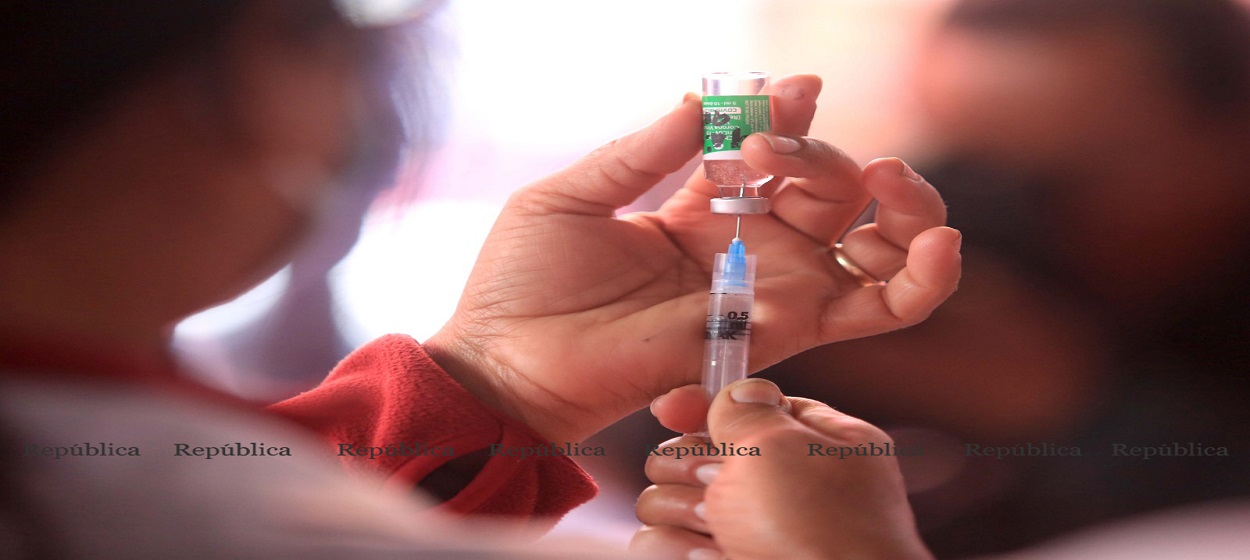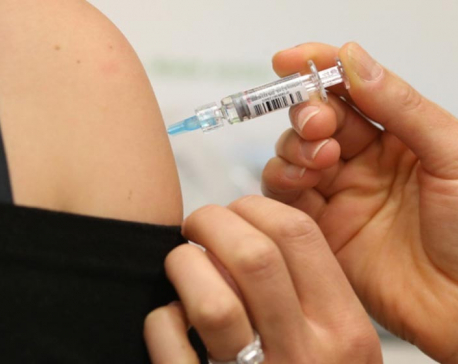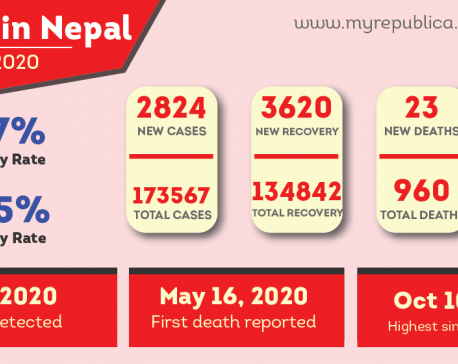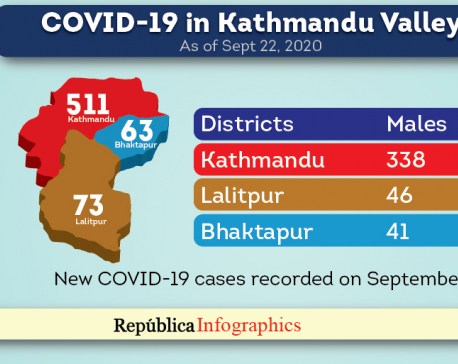
OR
Ill-managed vaccine centers could accelerate risk of third wave
Published On: July 17, 2021 02:17 PM NPT By: Sangay Sherpa

Kathmandu, July 17: The government of Nepal decided to administer COVID-19 vaccines to people above the age of 55 including teachers, lecturers, employees of educational institutions, health workers, staff of public vehicles, journalists, differently-abled people and refugees of all ages, living across the country from July 13.
Prior to the ongoing vaccination campaign, people above the age of 55 were administered vaccines against COVID-19 as well.
Although the government has started the initiative to vaccinate the population as fast as possible, the scenes at the vaccination centers are seen to be more of a threat, as hundreds of people gather outside the vaccination centers without maintaining any safe distance, awaiting their turn to get vaccinated. The risk of COVID-19 and the importance of vaccines have led thousands of people across the country to gather at vaccination centers.
Many of the people who arrive at the vaccination centers are seen complaining about the lack of proper management at the vaccination centers where people are made to stay in line for more than half a day in order to receive the vaccine. Some people even have to return home without getting vaccinated as some centers were short on doses.
According to virologist at Sukraraj Tropical and Infectious Disease Hospital at Teku in Kathmandu, Dr Sher Bahadur Pun, “The lack of proper management at vaccination centers is likely to accelerate the risk of a third wave.” “Prior to the second wave of COVID-19, many people who tested positive for the virus said that they had contracted the disease from the vaccination centers that they visited,” Pun informed Republica.
Last year, the number of people arriving at the vaccination centers was seen to be very low in some places compared to the crowds in vaccination centers at the moment. Only a few hundred people were seen in many of the vaccination centers across the country. The lack of confidence and trust in vaccines was also a major factor behind the low turnout. However, the number of people arriving at the vaccination centers has increased by a large number following the second wave of COVID-19. As large crowds gather outside the vaccination centers, it is necessary for the government to look for alternatives to solve the problem as soon as possible.
“The lack of proper management in vaccination campaigns which took place last year were also one of the causes of the increase in the infection rate,” Pun said. “People can be seen quarreling with each other and security personnel while gathering to receive the vaccines. Some of them are not even covering their mouths properly. I fear the ongoing problems surrounding the vaccination centers could infect many people in the upcoming days,” he said. “It may take 5 to 14 days for symptoms to occur in a human body. Though the number of infections is decreasing at the moment, it is likely to affect people who were present at large gatherings in the upcoming days,” Pun added.
Security personnels are seen requesting people to maintain a straight line with the required documents in order to receive the vaccine. However, no safety measures are followed nor are any instructions given.
The government decided to administer the vaccines to elderly people as they are more vulnerable to the infectious disease, but large gatherings at a single place without following any health and safety measures has triggered the risk of COVID-19 transmission at health institutions or vaccination centers.
According to experts and virologists, the movement of public and gathering for various activities has increased in various places across the country as they disregard the risk of infection. Furthermore, the stigma of not contracting the virus while standing in the line for vaccination is a complete hoax and the government should make mandatory protocols surrounding the problem. If such long queues at the vaccination centers continue, the rate of infection is more likely to increase than the initial plan to defeat the contagious virus.
“The increase in public movement and vehicles inside the country following the ‘smart lockdown’ has led people to disregard the omnipresent risk of the virus. People have started to gather for various activities without following the health and safety guidelines. I fear that the number of infections might increase in the upcoming days,” Dr Pun said.
Many countries have been very successful in effective rollout of vaccines to their citizens. Nepal can certainly follow their successful initiatives to distribute vaccines without creating long queues which will only accelerate the risk of a third wave. The government needs to create alternative ways for the people to receive their vaccines on time without the need to surge the risk of the infection more than it already is. The late decision-making and the longer implementing process from the administrative authorities will only trigger the spread of a third wave. It is way behind the time, the government authorities need to implement the best practices needed for mass vaccination without pressuring the health workers and institutions as well.
The WHO has also recommended vaccine strategies for efficient rollouts of vaccines to the mass.
The consideration for implementing effective vaccination strategies are as follows:
-Tailor strategies to enable the safest, most effective delivery of the vaccination campaign.
-Consider increasing the timeframe and number of sites to reduce the number of people vaccinated per site and allow for physical distancing.
-Consider tailored targeted campaigns in high risk areas and/or to high risk groups.
-Consider decentralizing vaccination sites using empty public or private premises.
-House-to-house vaccination could be considered if resources, logistical and Implementation, Prevention, Control (IPC) capacities are available.
-Use non-traditional methods to deliver vaccine, e.g. supervised self administration of OCV to reduce physical contact between vaccinators and recipients
Recommendations for organising the vaccination sites are as follows:
-Conduct sessions in well-ventilated, frequently disinfected areas.
-Ensure availability of hand sanitizer or equipped hand washing station at the entrance to vaccination sites and health facilities.
-Limit the number of people accompanying the person to be vaccinated.
-Maintain at least 1 metre distance between recipients and between companions.
-Maintain at least 1 metre distance between recipients and between companions.
-Screen recipients and companions to prevent spread of COVID-19 including assessing COVID-19 exposure risk and COVID-19 symptoms – If screening is negative – vaccination can proceed – If screening is positive – offer a medical mask, do not vaccinate, refer for COVID-19 evaluation, offer vaccination at COVID-19 evaluation site, or postpone vaccination for 14 days after symptom resolution, manage in accordance with WHO guidance.
-Avoid crowded waiting areas by iIntegrating vaccination with other essential health services.
-Planning small vaccination sessions and extending the duration of the campaign.
-Use outdoor spaces and adhere to physical distancing.
-Establish exclusive vaccination sessions for people with pre-existing medical conditions.
-Where possible, separate vaccination from curative services, e.g. by allocating different hours and different spaces.
You May Like This

Vaccination campaign resumes in Tokha Municipality
KATHMANDU, August 2: The COVID-19 vaccination campaign has resumed in Tokha municipality in Kathmandu. The campaign was halted after Basanta... Read More...

COVID-19 Updates: Nepal’s case tally jumps to 173,567 including 2,824 new cases confirmed on Sunday
KATHMANDU, Nov 1: Nepal on Sunday added 2,824 new cases of the novel coronavirus disease (COVID-19), reported the Ministry of... Read More...

Kathmandu Valley reports 647 new COVID-19 cases, one fatality
Total caseload in the Valley stands at 17,737; daily count records 600 plus for eight days in a row ... Read More...




Just In
- Govt receives 1,658 proposals for startup loans; Minimum of 50 points required for eligibility
- Unified Socialist leader Sodari appointed Sudurpaschim CM
- One Nepali dies in UAE flood
- Madhesh Province CM Yadav expands cabinet
- 12-hour OPD service at Damauli Hospital from Thursday
- Lawmaker Dr Sharma provides Rs 2 million to children's hospital
- BFIs' lending to private sector increases by only 4.3 percent to Rs 5.087 trillion in first eight months of current FY
- NEPSE nosedives 19.56 points; daily turnover falls to Rs 2.09 billion















Leave A Comment